Features
• Standard-voltage Operation
– 2.7 (VCC = 2.7V to 5.5V)
• Automotive Temperature Range –40°C to 125°C
• Internally Organized 128 x 8 (1K), 256 x 8 (2K), 512 x 8 (4K),
1024 x 8 (8K) or 2048 x 8 (16K)
• Two-wire Serial Interface
• Schmitt Trigger, Filtered Inputs for Noise Suppression
• Bidirectional Data Transfer Protocol
• 400 kHz Compatibility
• Write Protect Pin for Hardware Data Protection
• 8-byte Page (1K, 2K), 16-byte Page (4K, 8K, 16K) Write Modes
• Partial Page Writes are Allowed
• Self-timed Write Cycle (5 ms max)
• High-reliability
– Endurance: 1 Million Write Cycles
– Data Retention: 100 Years
• 8-lead JEDEC SOIC and 8-lead TSSOP Packages
Description
The AT24C01A/02/04/08A/16A provides 1024/2048/4096/8192/16384 bits of serial
electrically erasable and programmable read-only memory (EEPROM) organized as
128/256/512/1024/2048 words of 8 bits each. The device is optimized for use in many
automotive applications where low-power and low-voltage operation are essential.
The AT24C01A/02/04/08A/16A is available in space-saving 8-lead JEDEC SOIC and
8-lead TSSOP packages and is accessed via a two-wire serial interface. In addition,
the entire family is available in 2.7V (2.7V to 5.5V) versions.
Table 1. Pin Configurations
Function
Pin Name
Address Inputs
A0 − A2
SDA
Serial Data
Serial Clock Input
SCL
Write Protect
WP
NC
No Connect
8-lead SOIC
A0
A1
A2
GND
1
2
3
4
8
7
6
5
VCC
WP
SCL
SDA
8-lead TSSOP
A0
A1
A2
GND
1
2
3
4
8
7
6
5
VCC
WP
SCL
SDA
Two-wire
Automotive
Temperature
Serial EEPROM
1K (128 x 8)
2K (256 x 8)
4K (512 x 8)
8K (1024 x 8)
16K (2048 x 8)
AT24C01A
AT24C02(1)
AT24C04
AT24C08A
AT24C16A
Note: 1. AT24C02 not recom-
new
for
mended
design.
5092C–SEEPR–2/07
1
�
Absolute Maximum Ratings
Operating Temperature......................................−55°C to +125°C
*NOTICE:
Storage Temperature .........................................−65°C to +150°C
Voltage on Any Pin
with Respect to Ground ........................................ −1.0V to +7.0V
Maximum Operating Voltage .......................................... 6.25V
DC Output Current........................................................ 5.0 mA
Figure 1. Block Diagram
Stresses beyond those listed under “Absolute
Maximum Ratings” may cause permanent dam-
age to the device. This is a stress rating only and
functional operation of the device at these or any
other conditions beyond those indicated in the
operational sections of this specification is not
implied. Exposure to absolute maximum rating
conditions for extended periods may affect
device reliability.
Pin Description
SERIAL CLOCK (SCL): The SCL input is used to positive edge clock data into each
EEPROM device and negative edge clock data out of each device.
SERIAL DATA (SDA): The SDA pin is bi-directional for serial data transfer. This pin is
open-drain driven and may be wire-ORed with any number of other open-drain or open-
collector devices.
DEVICE/PAGE ADDRESSES (A2, A1, A0): The A2, A1 and A0 pins are device
address inputs that are hard wired for the AT24C01A and the AT24C02. As many as
eight 1K/2K devices may be addressed on a single bus system (device addressing is
discussed in detail under the Device Addressing section).
The AT24C04 uses the A2 and A1 inputs for hard wire addressing and a total of four 4K
devices may be addressed on a single bus system. The A0 pin is a no connect.
2
AT24C01A/02/04/08A/16A
5092C–SEEPR–2/07
�
AT24C01A/02/04/08A/16A
The AT24C08A only uses the A2 input for hardwire addressing and a total of two 8K
devices may be addressed on a single bus system. The A0 and A1 pins are no
connects.
The AT24C16A does not use the device address pins, which limits the number of
devices on a single bus to one. The A0, A1 and A2 pins are no connects.
WRITE PROTECT (WP): The AT24C01A/02/04/08A/16A has a Write Protect pin that
provides hardware data protection. The Write Protect pin allows normal read/write oper-
ations when connected to ground (GND). When the Write Protect pin is connected to
VCC, the write protection feature is enabled and operates as shown in the following
table.
Table 2. Write Protect
WP Pin
Status
At VCC
At GND
Part of the Array Protected
24C01A
24C02
24C04
24C08A
24C16A
Full (1K) Array
Full (2K) Array
Full (4K) Array
Full (8K) Array
Full (16K) Array
Normal Read/Write Operations
Memory Organization AT24C01A, 1K SERIAL EEPROM: Internally organized with 16 pages of 8 bytes each,
the 1K requires a 7-bit data word address for random word addressing.
AT24C02, 2K SERIAL EEPROM: Internally organized with 32 pages of 8 bytes each,
the 2K requires an 8-bit data word address for random word addressing.
AT24C04, 4K SERIAL EEPROM: Internally organized with 32 pages of 16 bytes each,
the 4K requires a 9-bit data word address for random word addressing.
AT24C08A, 8K SERIAL EEPROM: Internally organized with 64 pages of 16 bytes
each, the 8K requires a 10-bit data word address for random word addressing.
AT24C16A, 16K SERIAL EEPROM: Internally organized with 128 pages of 16 bytes
each, the 16K requires an 11-bit data word address for random word addressing.
5092C–SEEPR–2/07
3
�
Table 3. Pin Capacitance(1)
Applicable over recommended operating range from TA = 25°C, f = 1.0 MHz, VCC = +2.7V
Symbol
CI/O
CIN
Note:
Test Condition
Input/Output Capacitance (SDA)
Input Capacitance (A0, A1, A2, SCL)
1. This parameter is characterized and is not 100% tested.
Max
8
6
Units
pF
pF
Conditions
VI/O = 0V
VIN = 0V
Test Condition
Units
Table 4. DC Characteristics
Applicable over recommended operating range from: TA = −40°C to +125°C, VCC = +2.7V to +5.5V (unless otherwise noted)
Symbol
VCC1
ICC
ICC
ISB1
ISB2
ILI
ILO
VIL
VIH
VOL2
VOL1
Note:
Parameter
Supply Voltage
Supply Current VCC = 5.0V
Supply Current VCC = 5.0V
Standby Current VCC = 2.7V
Standby Current VCC = 5.0V
Input Leakage Current
Output Leakage Current
Input Low Level(1)
Input High Level(1)
Output Low Level VCC = 3.0V
Output Low Level VCC = 1.8V
Read at 100 kHz
Write at 100 kHz
VIN = VCC or VSS
VIN = VCC or VSS
VIN = VCC or VSS
VOUT = VCC or VSS
1. VIL min and VIH max are reference only and are not tested.
V
mA
mA
µA
µA
µA
µA
V
V
V
V
Max
5.5
1.0
3.0
4.0
18.0
3.0
3.0
Typ
0.4
2.0
1.6
8.0
0.10
0.05
VCC x 0.3
VCC + 0.5
0.4
0.2
Min
2.7
−0.6
VCC x 0.7
IOL = 2.1 mA
IOL = 0.15 mA
4
AT24C01A/02/04/08A/16A
5092C–SEEPR–2/07
�
AT24C01A/02/04/08A/16A
Table 5. AC Characteristics
Applicable over recommended operating range from TA = −40°C to +125°C, VCC = +2.7V to +5.5V, CL = 1 TTL Gate and
100 pF (unless otherwise noted)
Symbol
fSCL
tLOW
tHIGH
tI
tAA
tBUF
tHD.STA
tSU.STA
tHD.DAT
tSU.DAT
tR
tF
tSU.STO
tDH
tWR
Endurance(2)
Note:
Parameter
Clock Frequency, SCL
Clock Pulse Width Low
Clock Pulse Width High
Noise Suppression Time(1)
Clock Low to Data Out Valid
Time the bus must be free before
a new transmission can start(2)
Start Hold Time
Start Set-up Time
Data In Hold Time
Data In Set-up Time
Inputs Rise Time(2)
Inputs Fall Time(2)
Stop Set-up Time
Data Out Hold Time
Write Cycle Time
5.0V, 25°C, Page Mode
AT24C01A/02/04/08A/16A
Max
Min
400
1.2
0.6
0.1
1.2
0.6
0.6
0
100
0.6
50
1M
50
0.9
300
300
5
Units
kHz
µs
µs
ns
µs
µs
µs
µs
µs
ns
ns
ns
µs
ns
ms
Write Cycles
1. This parameter is characterized and is not 100% tested (TA = 25°C).
2. This parameter is characterized.
Device Operation
CLOCK and DATA TRANSITIONS: The SDA pin is normally pulled high with an exter-
nal device. Data on the SDA pin may change only during SCL low time periods (see to
Figure 4 on page 7). Data changes during SCL high periods will indicate a start or stop
condition as defined below.
START CONDITION: A high-to-low transition of SDA with SCL high is a start condition
which must precede any other command (see to Figure 5 on page 7).
STOP CONDITION: A low-to-high transition of SDA with SCL high is a stop condition.
After a read sequence, the stop command will place the EEPROM in a standby power
mode (see Figure 5 on page 7).
ACKNOWLEDGE: All addresses and data words are serially transmitted to and from
the EEPROM in 8-bit words. The EEPROM sends a “0” to acknowledge that it has
received each word. This happens during the ninth clock cycle.
STANDBY MODE: The AT24C01A/02/04/08A/16A features a low-power standby mode
which is enabled: (a) upon power-up and (b) after the receipt of the STOP bit and the
completion of any internal operations.
5092C–SEEPR–2/07
5
�
MEMORY RESET: After an interruption in protocol, power loss or system reset, any
two-wire part can be reset by following these steps:
1. Clock up to 9 cycles.
2. Look for SDA high in each cycle while SCL is high.
3. Create a start condition.
Bus Timing
Figure 2. SCL: Serial Clock, SDA: Serial Data I/O
Write Cycle Timing
Figure 3. SCL: Serial Clock, SDA: Serial Data I/O
SCL
SDA
8th BIT
ACK
WORDn
(1)
twr
STOP
CONDITION
START
CONDITION
Note:
1. The write cycle time tWR is the time from a valid stop condition of a write sequence to the end of the internal clear/write cycle.
6
AT24C01A/02/04/08A/16A
5092C–SEEPR–2/07
�
AT24C01A/02/04/08A/16A
Figure 4. Data Validity
Figure 5. Start and Stop Definition
SDA
SCL
START
Figure 6. Output Acknowledge
STOP
5092C–SEEPR–2/07
7
�
Device Addressing
Write Operations
The 1K, 2K, 4K, 8K and 16K EEPROM devices all require an 8-bit device address word
following a start condition to enable the chip for a read or write operation (see to Figure
7 on page 9).
The device address word consists of a mandatory “1”, “0” sequence for the first four
most significant bits as shown. This is common to all the Serial EEPROM devices.
The next 3 bits are the A2, A1 and A0 device address bits for the 1K/2K EEPROM.
These 3 bits must compare to their corresponding hardwired input pins.
The 4K EEPROM only uses the A2 and A1 device address bits with the third bit being a
memory page address bit. The two device address bits must compare to their corre-
sponding hardwired input pins. The A0 pin is no connect.
The 8K EEPROM only uses the A2 device address bit with the next two bits being for
memory page addressing. The A2 bit must compare to its corresponding hardwired
input pin. The A1 and A0 pins are no connect.
The 16K does not use any device address bits but instead the three bits are used for
memory page addressing. These page addressing bits on the 4K, 8K and 16K devices
should be considered the most significant bits of the data word address which follows.
The A0, A1 and A2 pins are no connect.
The eighth bit of the device address is the read/write operation select bit. A read opera-
tion is initiated if this bit is high and a write operation is initiated if this bit is low.
Upon a compare of the device address, the EEPROM will output a “0”. If a compare is
not made, the chip will return to a standby state.
BYTE WRITE: A write operation requires an 8-bit data word address following the
device address word and acknowledgment. Upon receipt of this address, the EEPROM
will again respond with a “0” and then clock in the first 8-bit data word. Following receipt
of the 8-bit data word, the EEPROM will output a “0” and the addressing device, such as
a microcontroller, must terminate the write sequence with a stop condition. At this time
the EEPROM enters an internally timed write cycle, tWR, to the nonvolatile memory. All
inputs are disabled during this write cycle and the EEPROM will not respond until the
write is complete (see Figure 8 on page 10).
PAGE WRITE: The 1K/2K EEPROM is capable of an 8-byte page write, and the 4K, 8K
and 16K devices are capable of 16-byte page writes.
A page write is initiated the same as a byte write, but the microcontroller does not send
a stop condition after the first data word is clocked in. Instead, after the EEPROM
acknowledges receipt of the first data word, the microcontroller can transmit up to seven
(1K/2K) or fifteen (4K, 8K, 16K) more data words. The EEPROM will respond with a “0”
after each data word received. The microcontroller must terminate the page write
sequence with a stop condition (see Figure 9 on page 10).
The data word address lower three (1K/2K) or four (4K, 8K, 16K) bits are internally
incremented following the receipt of each data word. The higher data word address bits
are not incremented, retaining the memory page row location. When the word address,
internally generated, reaches the page boundary, the following byte is placed at the
beginning of the same page. If more than eight (1K/2K) or sixteen (4K, 8K, 16K) data
words are transmitted to the EEPROM, the data word address will “roll over” and previ-
ous data will be overwritten.
ACKNOWLEDGE POLLING: Once the internally timed write cycle has started and the
EEPROM inputs are disabled, acknowledge polling can be initiated. This involves send-
8
AT24C01A/02/04/08A/16A
5092C–SEEPR–2/07
�

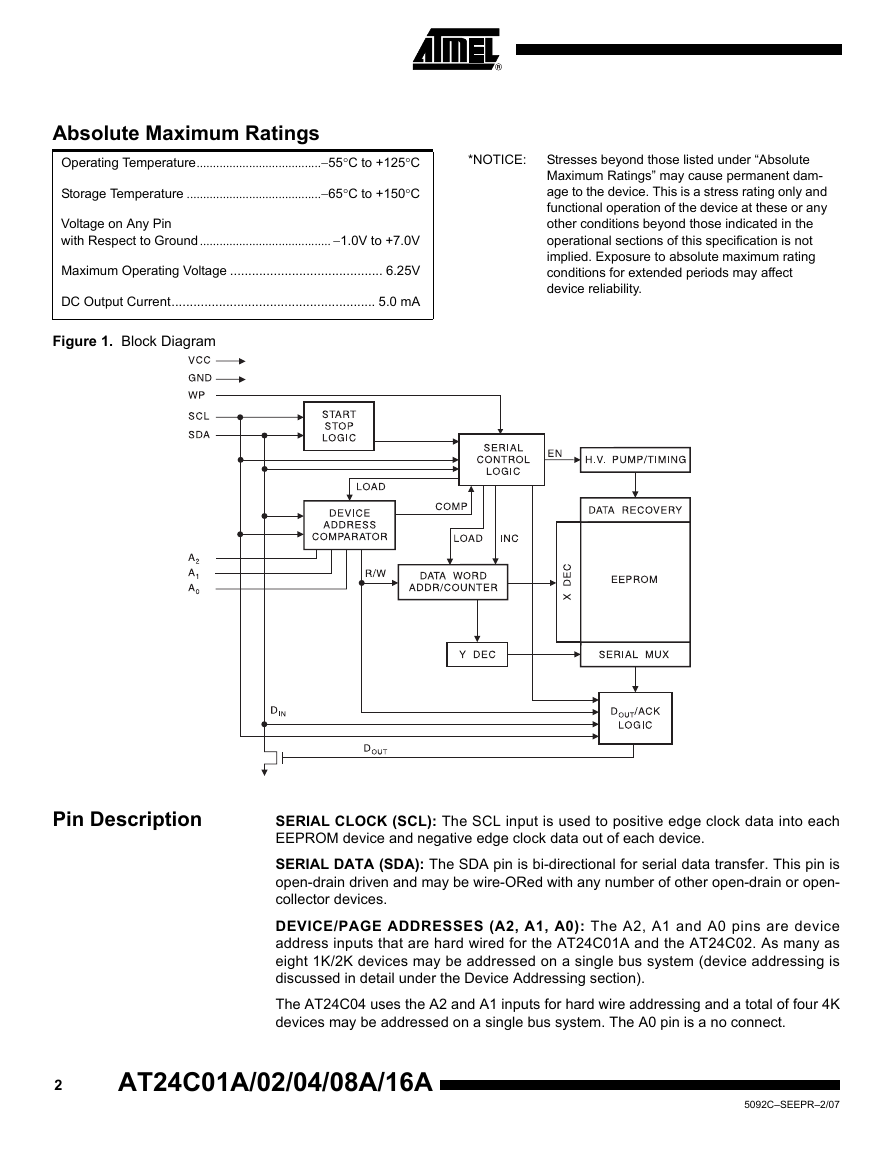
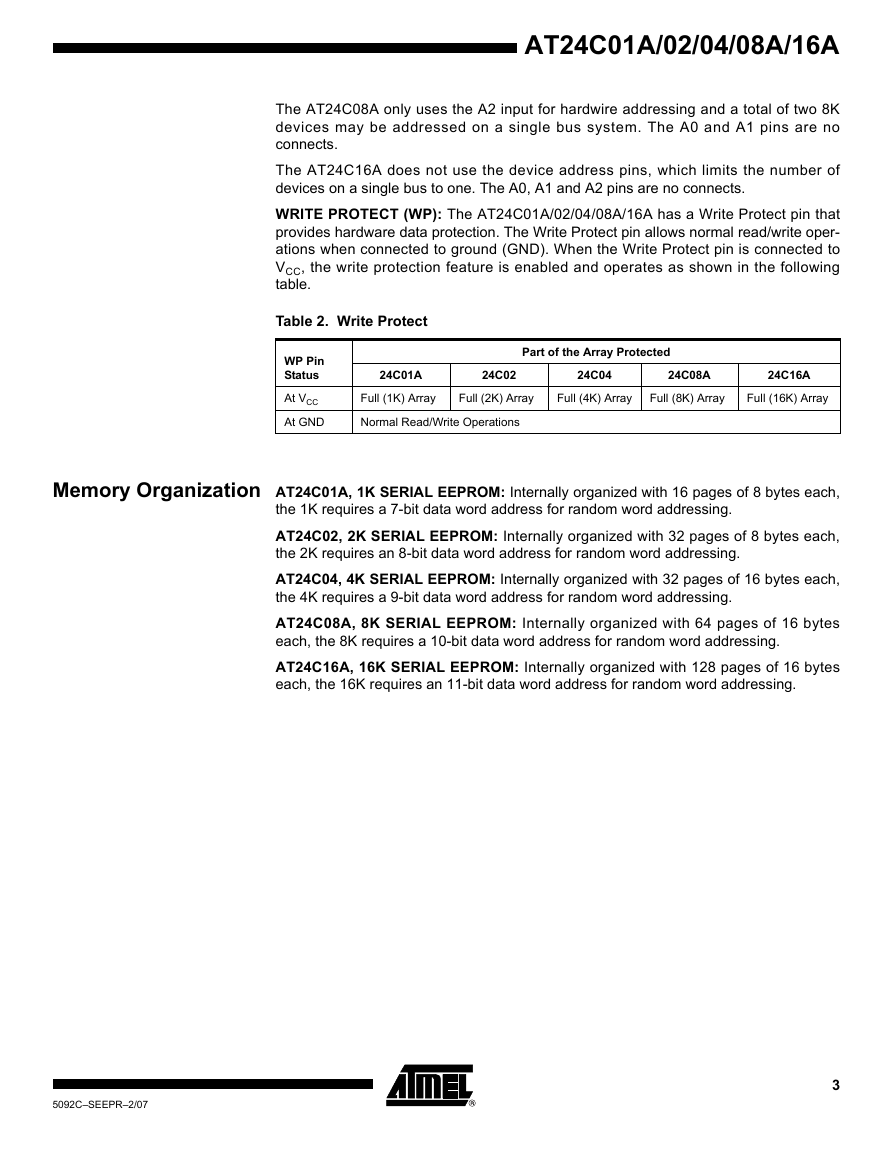
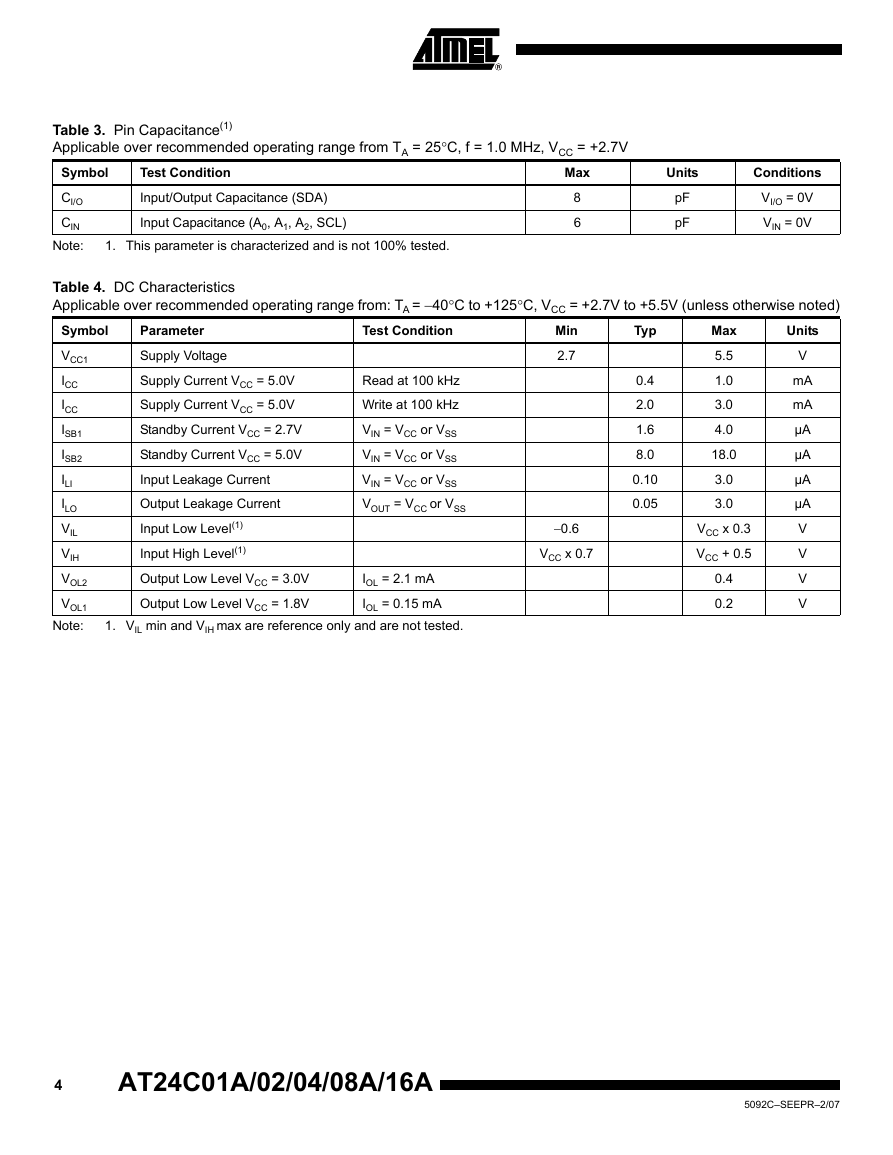
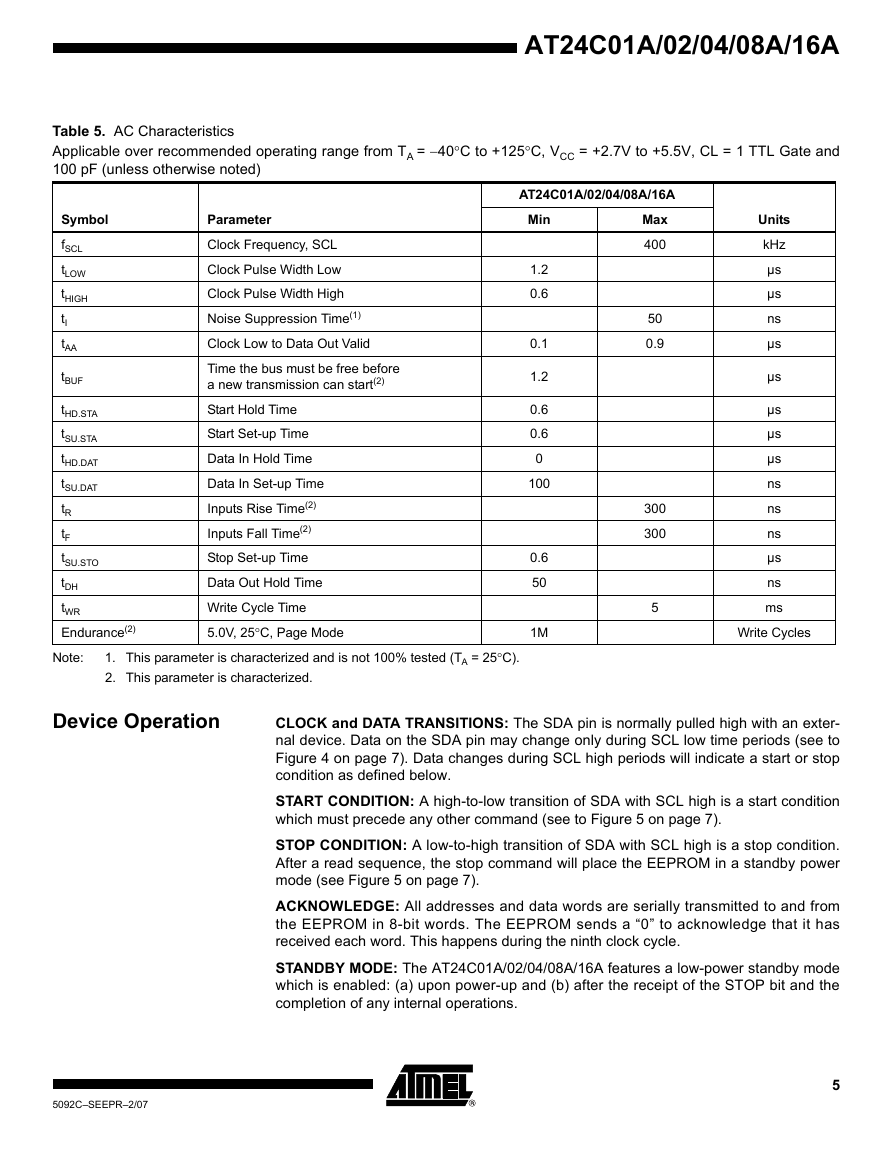

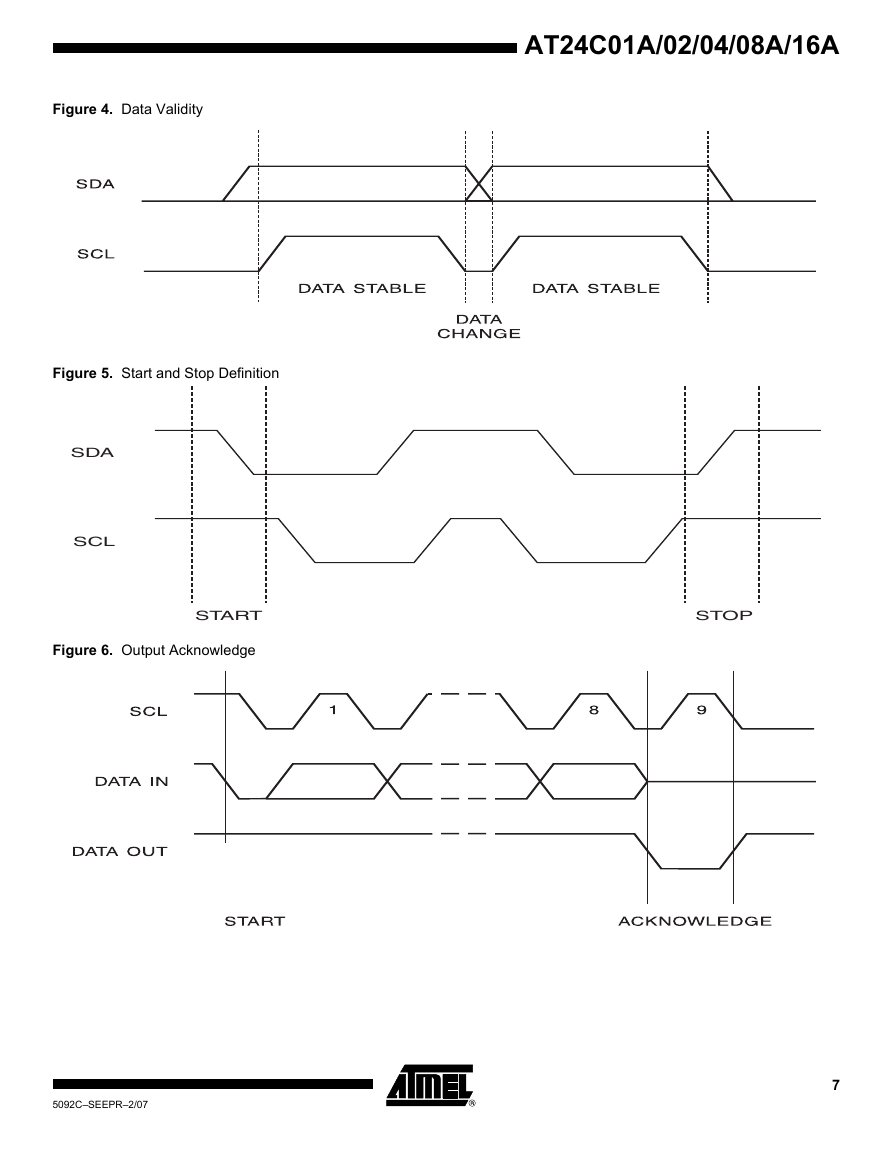
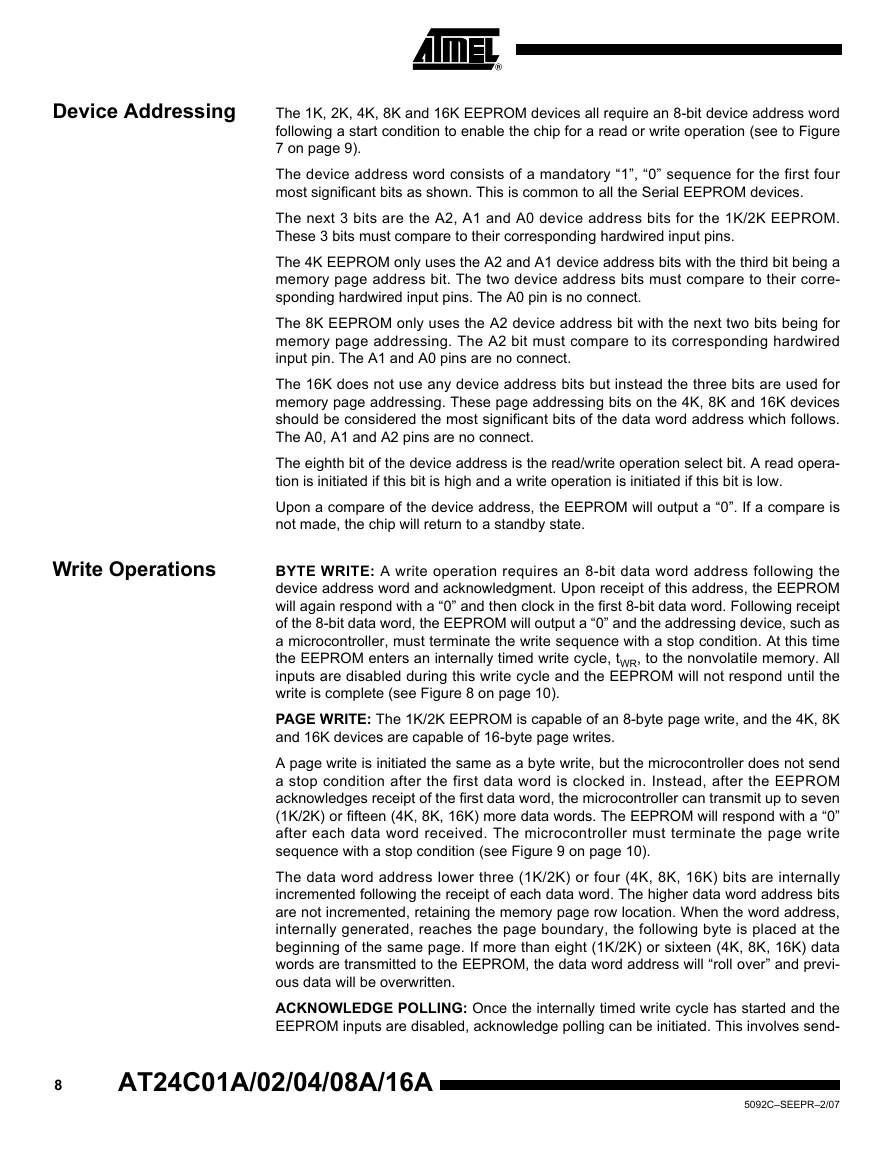








 uCOS-III的任务调度算法研究.pdf
uCOS-III的任务调度算法研究.pdf STM32F103x8B_DS_CH_V10(7STM32中文数据手册).pdf
STM32F103x8B_DS_CH_V10(7STM32中文数据手册).pdf FX2N系列PLC培训教程.pdf
FX2N系列PLC培训教程.pdf Modbus协议资料.pdf
Modbus协议资料.pdf WM8978中文资料(芯片资料).doc
WM8978中文资料(芯片资料).doc 5-1.【Codelab】HarmonyOS基于图像模块实现图库图片的四种常见操作.pdf
5-1.【Codelab】HarmonyOS基于图像模块实现图库图片的四种常见操作.pdf GX Developer 编程软件使用说明.pdf
GX Developer 编程软件使用说明.pdf MR-E伺服与FX3G接线图.pdf
MR-E伺服与FX3G接线图.pdf ATK-NEO-6M GPS模块常见问题汇总_201400721.pdf
ATK-NEO-6M GPS模块常见问题汇总_201400721.pdf STM32F407ZGT6(芯片资料).pdf
STM32F407ZGT6(芯片资料).pdf FM1715编程指南.pdf
FM1715编程指南.pdf Profibus教程-7.PROFIBUS-FMS.pdf
Profibus教程-7.PROFIBUS-FMS.pdf